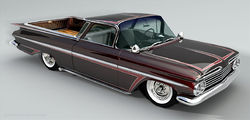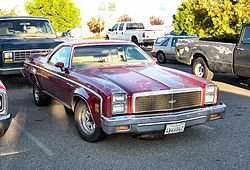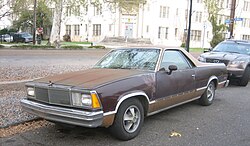Chevrolet El Camino
| Chevrolet El Camino | |
|---|---|
 | |
| Manufacturer | Chevrolet |
| Parent company | General Motors |
| Production | 1959–1960 1964–1987 |
| Successor | Pontiac G8 ST |
| Class | Coupe utility |
| Layout | FR layout |
The Chevrolet El Camino (Spanish translation: "the road") was a coupe utility built by Chevrolet in the United States from 1959 to 1960, with production resuming in 1964 and continuing through 1987. It was based on corresponding Chevrolet car lines and produced in response to the success of the rival Ford Ranchero. During 1978 through 1987, the El Camino was sold under four main models: The Super Sport, The Black Knight, The Conquista, and the regular El Camino. It also had a twin called the GMC Sprint and later the GMC Caballero from 1974 onward.
As is often the case with vehicles of this type, El Caminos are referred to incorrectly as cars because of their car heritage; in North America, the vehicle is classified as a truck and titled as such.
In Mexico, it was sometimes badged and sold as the Chevrolet Conquistador.
First generation (1959-1960)
| First generation | |
|---|---|
 | |
| Production | 1959–1960 |
| Engine(s) | 235 in³ Inline-Six I6 283 in³ Small-Block V8 348 in³ Big-Block V8 |
| Related | Chevrolet Brookwood |
The first El Camino was produced for the 1959 model year (two years after the Ford Ranchero) and, like the Ranchero, was based on an existing and easily modified platform, namely the new-for-1959 Brookwood two-door station wagon and corresponding sedan delivery variant; unlike those more pedestrian versions, the El Camino was available with any trim level and drivetrain option corresponding to the car line, including that of the Chevrolet Impala. This was also the first year of the flamboyant "batwing" full-sized Chevrolet which sold in fewer numbers than more conservatively styled Fords. So too did the El Camino suffer in comparison to the Ranchero with 22,246 built the first year. The similar but less flamboyant 1960 model sold even worse at 14,163 units total at which point General Motors decided to discontinue the model. In total, 36,409 first generation El Caminos were produced.
Second generation (1964-1967)
| Second generation | |
|---|---|
 | |
| Production | 1964–1967 |
| Assembly | Atlanta, Georgia Baltimore, Maryland Fremont, California Framingham, Massachusetts Kansas City, Missouri Oshawa, Ontario, Canada |
| Platform | A-body |
| Engine(s) | 327 in³ Small-Block V8 396 in³ Big-Block V8 |
| Related | Chevrolet Chevelle Chevrolet Malibu |
Four years later, with the Ranchero still selling well, Chevrolet reincarnated the El Camino, based on the then-new Chevrolet Chevelle. That 1964 model was basically identical to the Chevelle forward of the B-pillars, but Chevrolet considered the vehicle a practical, utility model and the Chevelle's most powerful engines were not available.
1965 saw the availability of performance versions of the 327 engine with some 350 hp (261 kW). 1966 brought added a 396 in³ engine to the lineup rated from 325 to 375 hp (280 kW). The 1965 327 would run low 15s in the 1/4 mile (at some 90 mph), while 1966 to 1969 models were easily into the mid- to upper-14s. The El Camino followed the Chevelle's styling update for 1967, with a new grille, front bumper, and trim. Air shocks were introduced, allowing the driver to compensate for a load.
The year 1967 also brought options of disc brakes, Turbo 400 3 speed tranmission and the collapsable steering column for the first time. It was the pinnacle year for the 2nd generation El Camino. 2,565 El Camino Customs came with the 396 big block. That option came with the Powerglide, Turbo-Hydro 400 automatic, manual 3 speed or two choices of 4 speed manual Muncie transmissions. The 396 four speed equipped El Caminos were the most rare with less than 500 units sold.
Third generation (1968-1972)
| Third generation | |
|---|---|
 | |
| Also called | GMC Sprint |
| Production | 1968–1972 |
| Assembly | Arlington, Texas Atlanta, Georgia Baltimore, Maryland Flint, Michigan Fremont, California Kansas City, Missouri Van Nuys, California Oshawa, Ontario, Canada |
| Platform | A-body |
| Engine(s) | 350 in³ Small-BlockSmall-Block V8 396 in³ Big-Block V8 402 in³ Big-Block V8 454 in³ LS6 V8 |
| Related | Chevrolet Chevelle Chevrolet Malibu |
1968 introduced a longer El Camino, based on the station wagon/4-door sedan wheelbase. A new, high performance Super Sport SS396 version was launched, alongside the Chevelle version. 1969 models were very similar, but 1970 saw the availability of a new SS396 which actually displaced 402 in³ (although all emblems read 396). Chevrolet's largest and most-powerful engine of the time was also put into a select few El Caminos. The LS6 454 in³ engine, rated at 450 hp (336 kW) and 500 lb·ft (680 N·m) of torque, gave the El Camino 1/4 mile times in the upper 13 second range at almost 105 mph (169 km/h). 1969 also marked the first time that the legendary Chevrolet 350 V-8 was used in an El Camino.
The 1971 model saw reduced power and performance, along with the rest of Chevrolet's line, as lower-octane unleaded fuel was mandated, and emissions controls began to be felt. Single headlights replaced double for 1971, and the grille came now to a point. Little changed but still lower power outputs for 1972.
A rebadged El Camino called the GMC Sprint debuted in 1971.
Fourth generation (1973-1977)
| Fourth generation | |
|---|---|
 | |
| Also called | GMC Sprint |
| Production | 1973–1977 |
| Assembly | Baltimore, Maryland Doraville, Georgia Leeds, Missouri Arlington, Texas Fremont, California Oshawa, Ontario, Canada |
| Platform | A-body |
For 1973, the El Camino was restyled again, matching changes to the Chevelle. It was the largest generation of El Camino, but thanks to lighter construction, it weighed less than the previous generation. A front-end restyle with quad stacked headlights was done in 1976, but otherwise it was the same truck until 1978.
Fifth generation (1978-1987)
| Fifth generation | |
|---|---|
 | |
| Also called | GMC Caballero |
| Production | 1978–1987 |
| Assembly | Baltimore, Maryland Doraville, Georgia Leeds, Missouri Arlington, Texas Fremont, California Oshawa, Ontario, Canada Ramos Arizpe, Mexico |
| Platform | A-body (1978-1981) G-body (1982-1987) |
| Engine(s) | 5.7 L Small-Block V8 5.0 L Small-Block V8 4.3 L 3.8 L |
| Wheelbase | 108 in (2743 mm) |
| Related | Buick Regal Chevrolet Malibu Chevrolet Monte Carlo Pontiac Grand Prix |
A new, smaller El Camino was unveiled in 1978, with more sharp-edged styling. With a single headlight design, until a later revision in 1982 that had a four headlight design on the same body style as previous years from 1978 to 1981. The El Camino instead shared components with the Chevrolet Malibu (The Chevelle name had been dropped) and Chevrolet Monte Carlo. V6 engines (based on the Buick or Chevrolet 90-degree V6) were available for the first time, and from 1982 through 1984, Oldsmobile-sourced diesel engines.
After 1984, GM shifted El Camino production to Mexico for three more years. Production ceased after the 1987 model year, as sales of the Chevrolet S-10 true pickup truck were outselling its passenger car counterpart.
1985 to 1987 El Caminos (and its twin, the GMC Caballero) were produced in Ramos Arizpe, Mexico. Around 425 unsold 1987 El Caminos were sold as 1988 models.
The El Camino today
Many El Caminos are still used as daily drivers, and some are used in various racing venues. The 1980s version is the most popular of any of that generation of body styles, though the late 60s command the highest prices and inspire the most replicas from Hot Wheels, Matchbox and Johnny Lightning which have produced few Ford Rancheros[citation needed]. The Discovery Channel program Monster Garage once turned an El Camino into a Figure-8 racer (dubbed the "Hell-Camino"). The drift team Bubba Drift uses a 1986 El Camino as the only drifting truck. It is one of the few drift trucks that uses an automatic transmission instead of a manual transmission.
The titular character of My Name Is Earl owns a 1973 fourth generation El Camino, although it has suffered damage and now has several replacement parts, including a 1980s hood. The main character of the movie ATL, played by T.I., drives an El Camino. In the animated King of the Hill, Khan trades in his Nissan Maxima for a 1980s El Camino as he transforms into a redneck, and he parks it visibly in the parking lot to help generate sympathy for his daughter who is applying for college. On the television series Prison Break, "Scan" portrayed fugitive Fernando Sucre hotwiring an El Camino pickup in Defiance, Ohio. In the sitcom That 70's Show the character Steven Hyde owns a second generation El Camino. The movie Enemy of the State features a blue El Camino, driven by Gene Hackman. Benny drives an El Camino in Benny and Joon. In the movie The Mexican, Brad Pitt is driving a "real Mexican" El Camino of the second generation. In Grand Theft Auto: San Andreas, Ryder drives a fourth-generation El Camino look-alike called a Picador. In the TV series Crossing Jordan, Dr. Jordan Cavanaugh (Jill Hennessey) drives a red late 1960s El Camino.
The El Camino is ostensibly the subject of the songs "El Camino," by Ween and "El Caminos in the West" by Grandaddy. It is mentioned in the lyrics of several country music songs as well:
- 69 El Camino by Southern Culture on the Skids
- Good Night To Be Lonely by Mark Chesnutt
- What's Not to Love by Blue County
- Feels Just Like It Should by Pat Green which opens with the line: "Let's jump in my El Camino"
- Something To Believe In by John Rich
- Jalapeno by Big & Rich
- Sister by Cross Canadian Ragweed
- Dirty Girl by Terri Clark
- Lake Charles by Lucinda Williams
- Rachel's Song by James McMurtry
- It Takes A Man by Aaron Lines
- What I Like About Texas by Jerry Jeff Walker
- Ballad Of Tommy and Marla by Reckless Kelly
- Lucky 4 You by SHeDAISY
- Fat Lip by Sum 41
- Mescalero by ZZ Top
- Route 66 by Asleep at the Wheel
- El Camino by Mott the Hoople
- El Camino Car Crash by Swing Kids (band)
On a production note, it has been constantly rumored for years now that GM may bring back the El Camino. During the 1995 model year, GM had a concept El Camino based on the full-size Caprice station wagon using the grille of a 1994-96 Impala SS; this concept was destined for production but terminated due to GM's profitable SUV sales. GM already has a vehicle ready in Australia in the form of the Holden Ute, save for some minor changes necessary to make it available in the U.S. This may have been backtracked within the past couple of years, however, as the Subaru Baja, the only "pickup car" recently available in the US, didn't sell well at all and was dropped after the 2006 model year. In addition, the Pontiac GTO (which Holden built and exported for Pontiac and was loosely related to the Holden Ute) didn't sell well either and was only programmed for three years ending in 2006 due to Holden upgrading the platform it was based on. A Chevrolet badged version, known as the Lumina Ute, is sold in South Africa. It has been recently rumored that the Holden Ute will be brought to the States first as a GMC concept and then as the Pontiac G8ST. Now it has been officially confirmed that Pontiac-badged Ute will be brought to USA with first cars coming to showrooms in late 2009 according to Motor Trend.





![Validate my RSS feed [Valid RSS]](valid-rss-rogers.png)















































































ไม่มีความคิดเห็น:
แสดงความคิดเห็น